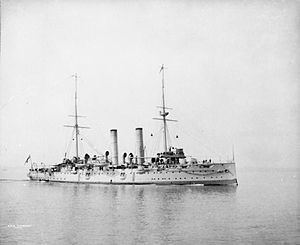Name HMS Crescent Speed 20 knots (37 km/h) Launched 30 March 1892 Weight 7,824 tons | Laid down 13 October 1890 Beam 60.75 ft (18.52 m) Construction started 13 October 1890 Length 118 m Displacement 6.985 million kg | |
 | ||
Fate Sold for breaking up 22 September 1921 | ||
HMS Crescent was a first class cruiser of the Edgar class. Crescent, and her sister ship Royal Arthur, were built to a slightly modified design and are sometimes considered a separate class. She was launched in 1892, saw early service at the Australia Station and the North America and West Indies Station, served in the First World War, and was sold for breaking up in 1921.
Contents
Construction
Crescent had a length of 387 feet 6 inches (118.11 m) long overall and 360 feet (109.73 m) between perpendiculars, with a beam of 60 feet (18.29 m) and a draught of 23 feet 9 inches (7.24 m). She displaced 7,350 long tons (7,470 t). Armament consisted of two 9.2 inch guns, on the ships centreline, backed up by ten six-inch guns, of which four were in casemates on the main deck and the remainder behind open shields. Twelve 6-pounder and four 3-pounder guns provided anti-torpedo-boat defences, while four 18 inch torpedo tubes were fitted.
The Edgars were protected cruisers, with an arched, armoured deck 5–3 inches (127–76 mm) thick at about waterline level. The casemate armour was 6 inches (152 mm) thick, with 3 inches (76 mm) thick shields for the 9.2 inch guns and 10 inches (254 mm) armour on the ship's conning tower. It contained four double-ended cylindrical Fairfields boilers feeding steam at 150 pounds per square inch (1,000 kPa) to 2 three-cylinder triple expansion engines, which drove two shafts. This gave 12,000 indicated horsepower (8,900 kW) under forced draught, giving a speed of 20 knots (37 km/h; 23 mph).
She was built at Portsmouth and launched on 30 March 1892.
Service history
Crescent had her first commission at the Australia Station. On 11 January 1895 she left Australia under Captain Arbuthnot.
From 1899 until 1902 she was flagship of Vice-Admiral Sir Frederick Bedford, Commander-in-Chief North America and West Indies Station. She visited Trinidad, Jamaica and Bermuda in February 1900, under the command of Captain Sawle, and Captain Stanley Colville was appointed in command from 1 March 1900. Commander Henry Hervey Campbell was appointed in command in May 1902, and the same month she visited Bermuda, but she was back at the station headquarters at Halifax, Nova Scotia for coronation celebrations in June. Bedford was succeeded as Commander-in-Chief at the station on 15 July 1902, when he left homebound with the Crescent, which was succeeded as flagship of the station by the HMS Ariadne. She arrived at Spithead on 24 July, and paid off the following month.
She served in the First World War, and was sold on 22 September 1921 for breaking up in Germany.
